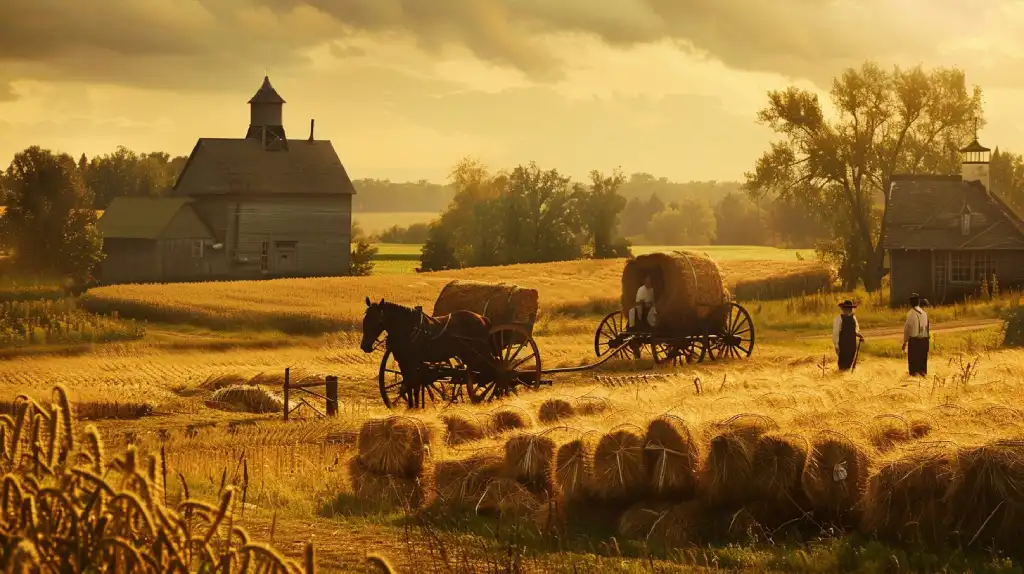The Second Agricultural Revolution occurred from the 17th to 19th centuries. It brought big changes in farming due to major improvements in agricultural technology.
Second Agricultural Revolution greatly boosted crop yields, allowing a single farmer to feed many more people than before.
Second Agricultural Revolution introduced crop rotation, which helped prevent soil reduction.
Second Agricultural Revolution was marked by the modernization of agriculture, such as the invention of the seed drill, increased efficiency and reduced labor needs.
Agricultural Revolutions
Agricultural revolutions are important periods of change in farming practices. The first revolution marked the change from hunting and gathering to settled agriculture.
The Second Agricultural Revolution built on these improvements, initiating new technologies and methods that further revolutionized farming.
The Agricultural Revolution was a period of impressive improvements in farming methods that began in Britain during the 17th and 18th centuries.
By introducing methods such as crop rotation, selective breeding, and modernization, farmers significantly increased food production, resulting in population growth and preparing for the Industrial Revolution.
Second Agricultural Revolution

Second agricultural revolution was time when farming became faster and easier with new tools and ideas.
The Second Agricultural Revolution (17th-19th centuries) was a period of rapid technological development and increased agricultural productivity, mainly in Britain.
Important developments included:
- Boundaries: Merging small farms into larger, more efficient ones.
- Crop rotation: Improved soil fertility and crop yields.
- Selective breeding: Developing higher-yielding livestock and crops.
- Industrialization: Using tools and machines for farming, increasing efficiency.
This revolution led to increased food production, population growth, and urbanization, laying the foundation for the Industrial Revolution.
Importance of the Second Agricultural Revolution
The Second Agricultural Revolution was crucial as it increased agricultural productivity and efficiency.
This period saw the launch of new crops, improved farming techniques, and machinery that changed agriculture.
These changes laid the base for modern farming, supporting growing populations and economies.
Factors Leading to the Second Agricultural Revolution
Several factors supported the Second Agricultural Revolution, including the need to support increasing populations and the availability of new technologies.
Innovations such as the seed drill and improvements in breeding practices allowed more efficient and sustainable agriculture.
Also, the rise of scientific thinking promoted experimentation and innovation in agriculture.
Pre-Revolutionary Farming Practices
Before the Second Agricultural Revolution, farming was labor-intensive and largely manual.
Practices included simple crop rotation, fallowing, and animal husbandry. Tools were basic, and yields were relatively low.
These methods limited the amount of food that could be produced, which in turn limited population growth and economic development.
4 Major Developments

1. Introduction of New Crops and Farming Methods
The revolution launched a variety of new crops and farming methods.
For example, crops such as potatoes and maize were integrated into European agriculture, providing more diverse and strong food sources.
Methods such as selective breeding and improved plowing methods improved crop yields and farming efficiency.
2. Beginning of Crop Rotation and Selective Breeding
Crop rotation, a practice where different crops are planted in sequence to maintain soil fertility, became widespread.
Selective breeding of plants and animals led to the development of more productive and disease-resistant varieties.
These practices improved food security and supported to better nutrition for populations.
3. Improvements in Machinery and Tools
The beginning of machinery such as the seed drill and harvesting machine revolutionized farming.
These tools allowed for more detailed planting and efficient harvesting, reducing labor needs and increasing productivity.
The industrialization of agriculture played a vital function in meeting the food demands of growing populations.
4. Industrialization of Agriculture
Agriculture became more industrialized, with larger farms and more focused farming practices.
The use of machinery, improved fertilizers, and better pest control methods increased crop yields and efficiency.
This industrial approach to farming also supported the development of agribusiness and rural economies.
Impact on Society and Economy
Changes in Food Production and Distribution
The revolution greatly increased food production, making food more plentiful and available.
This growth supported population expansion and urbanization.
Improved transportation networks, such as railways and canals, helped the distribution of agricultural products, connecting rural producers with urban markets.
Effects on Population Growth and Urbanization
The increased availability of food supported significant population growth. As agricultural productivity rose, fewer people were needed to work the land, leading to urban migration.
This change supported to the growth of cities and the development of industrial economies, changing the social and economic structure of many countries.
Economic Consequences
The revolution had big economic effects, including the growth of agricultural markets and the rise of agribusiness.
It also led to changes in land ownership and labor practices, with some traditional farming communities being displaced.
The increased productivity supported economic growth and contributed to the rise of the modern economy.
The Bottom Line
The Second Agricultural Revolution was a revolutionary period in history, marked by big improvements in farming practices and technology.
These changes led to increased food production, supported population growth, and contributed to economic development.
The revolution also created the way for future agricultural innovations.
The practices and technologies developed during the Second Agricultural Revolution have left a lasting legacy in modern agriculture.
Today’s farming techniques, machinery, and crop management practices are deeply rooted in the innovations of this period.
The revolution set the foundation for the continued growth and development of global agriculture.
FAQ's
1. What did the Second Agricultural Revolution do?
The Second Agricultural Revolution improved farming by using better crop planning, breeding stronger plants, and better farming tools.
2. What major event was the catalyst for the 2nd Agricultural Revolution?
The Industrial Revolution was the primary catalyst for the Second Agricultural Revolution.




